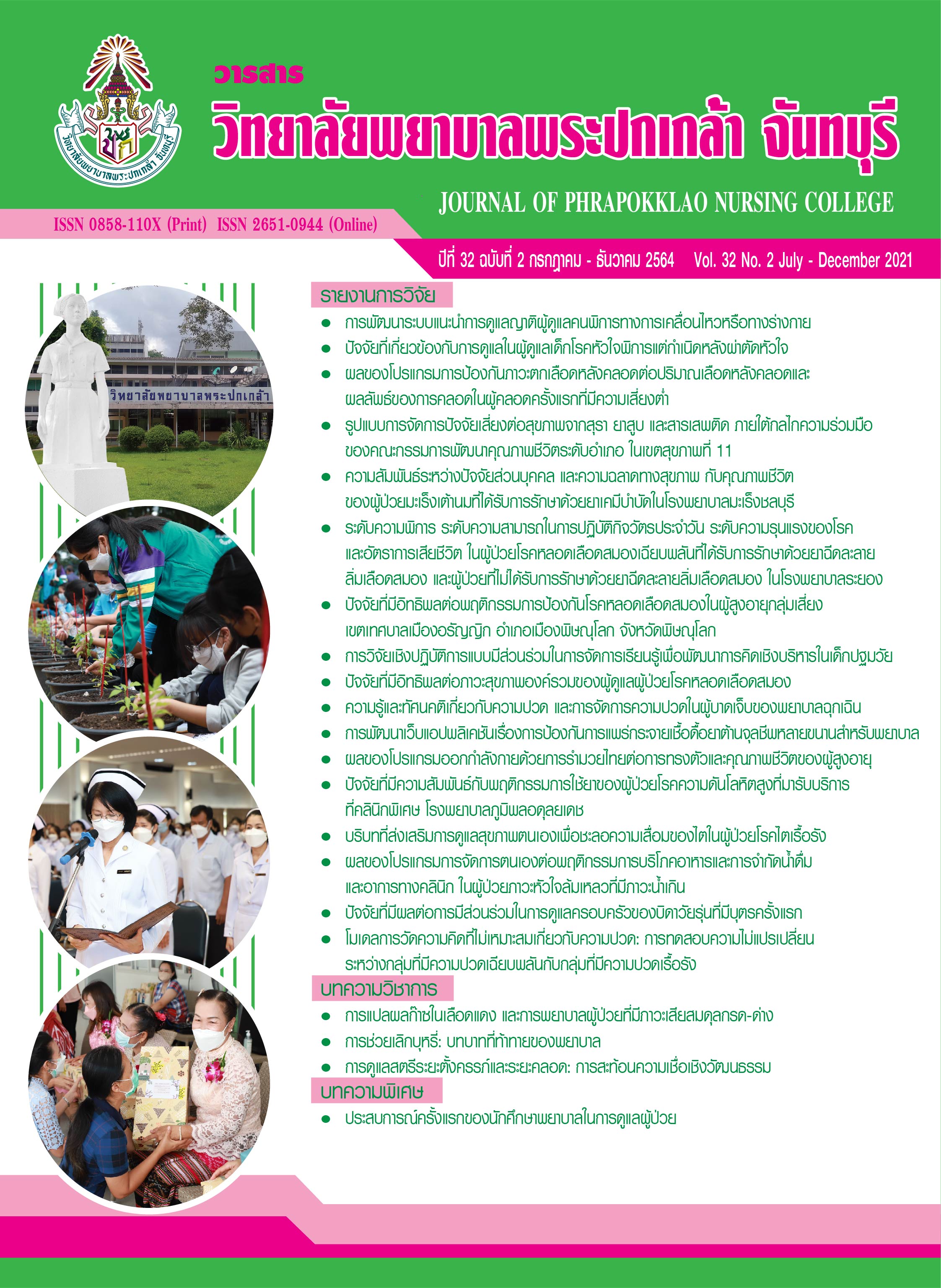The Modified Rankin Scale, The Barthel’s ADL Index, The National Institute of Health Stroke Scale, and Death Rate of Acute Stroke Patients Receiving Thrombolytic Agent Therapy and Not Receiving Thrombolytic Agent Therapy in Rayong Hospital
Keywords:
The modified Rankin Scale, The Barthel’s ADL index, The National Institute of Health Stroke Scale, Thrombolytic agent therapy, Stroke unitAbstract
This descriptive research aimed to study the Modified Rankin Scale (morbidity level), the Barthel’s ADL index (ADL capacity), the National Institute of Health Stroke Scale (severity level), and mortality rate of acute stroke patients receiving and not receiving thrombolytic agent therapy. The samples were 1,728 medical records of acute ischemic stroke patients who received services at Rayong Hospital, fiscal year 2018 and 2019. The research instruments were composed of the general data record form, the Modified Rankin Scale, the Barthel’s ADL index, and the National Institute of Health Stroke Scale. Data were collected from September to December, 2020. Statistics used for data analysis included frequency, percentage, mean, standard deviation, Wilcoxon signed-rank test, Mann-Whitney U test, and Chi-square test.
The research results revealed that 1) on the day of discharge, the patients receiving and not receiving thrombolytic agent therapy had statistically significant lower mean scores of morbidity level and severity level, and higher mean score of ADL capacity than those on the day of admission (p < .001); 2) on the day of admission, the patients receiving thrombolytic agent therapy had statistically significant higher mean scores of morbidity level and severity level, and lower mean score of ADL capacity than those of the patients not receiving thrombolytic agent therapy (p < .001). In addition, on the day of discharge (fiscal year 2019), the patients receiving thrombolytic agent therapy had statistically significant lower mean score of severity level than that of the patients not receiving thrombolytic agent therapy (p < .05); and 3) the mortality rate of the patients receiving and not receiving thrombolytic agent therapy were not different.
This research suggests that healthcare executives should promote setting stroke unit in the hospitals as well as develop a standard of care for stroke patients who cannot receive thrombolytic agent therapy in time.
References
กองยุทธศาสตร์และแผนงาน สำนักงานปลัดกระทรวงสาธารณสุข. (2561). สถิติสาธารณสุข พ.ศ. 2560. สืบค้นจาก http://www.pcko.moph.go.th/Health-Statistics/stratistics60.pdf
นันทิยา แสงทรงฤทธิ์. (2555). การดูแลและเฝ้าระวังการเกิดภาวะเลือดออกในสมองภายหลังได้รับยาละลายลิ่มเลือด (rt-PA) ในผู้ป่วยโรคสมองขาดเลือดเฉียบพลัน. วารสารพยาบาลสภากาชาดไทย, 5(1), 9–18.
ศูนย์ข้อมูลข่าวสาร สถาบันประสาทวิทยา. (2562). Standard Stroke Center Certification & Stroke Fast Track. สืบค้นจาก https://dhes.moph.go.th
ศูนย์ข้อมูลข่าวสาร โรงพยาบาลระยอง. (2562). สถิติผู้ป่วยโรคหลอดเลือดสมอง ปี 2562. ระยอง: ผู้แต่ง.
สถาบันประสาทวิทยา. (2558). แนวทางการพยาบาลผู้ป่วยโรคหลอดเลือดสมองสำหรับพยาบาลทั่วไป. สืบค้นจาก https://rbpho.moph.go.th/upload-file/doc/files/011518-1453-9113.pdf
สำนักงานพัฒนานโยบายสุขภาพระหว่างประเทศ. (2560). การสูญเสียปีสุขภาวะ: รายงานภาระโรคและการบาดเจ็บของประชากรไทย พ.ศ. 2557. นนทบุรี: เดอะ กราฟิโก ซิสเต็มส์.
สำนักนโยบายและยุทธศาสตร์ กระทรวงสาธารณสุข. (2561). สถิติสาธารณสุข พ.ศ. 2561. สืบค้นจาก http://dmsic.moph.go.th/index/detail/7892
หอผู้ป่วยโรคหลอดเลือดสมอง โรงพยาบาลระยอง. (2562). สถิติผู้ป่วยโรคหลอดเลือดสมอง ปี 2560–2562. ระยอง: ผู้แต่ง.
อัจฉรา อักษรรัตน์. (2561). ผลลัพธ์ของการดูแลรักษาผู้ป่วยโรคหลอดเลือดสมองตีบ/อุดตันเฉียบพลันด้วยยาละลายลิ่มเลือดทางหลอดเลือดดําในโรงพยาบาลสิชล. วารสารวิชาการแพทย์ เขต 11, 32(1), 767–782.
อาภรณ์ คําก้อน. (2553). การตรวจทางระบบประสาท I. สืบค้นจาก http://www.ns.mahidol.ac.th/english/th/departments/MN/th/km_Nervous_system1.html
Bartol, K. M., & Martin, D. C. (1998). Management (3rd ed.). New York: McGraw-Hill.
Benjamin, E. J., Blaha, M. J., Chiuve, S. E., Cushman, M., Das, S. R., Deo, R., … Muntner, P. (2017). Heart disease and stroke statistics – 2017 update: A report from the American Heart Association. Circulation, 135(10), e146–e603. doi:10.1161/CIR.0000000000000485
Broderick, J. P., Adeoye, O., & Elm, J. (2017). Evolution of the modified Rankin Scale and its use in future stroke trials. Stroke, 48(7), 2007–2012. doi:10.1161/STROKEAHA.117.017866
Fatima, N., Saqqur, M., Hussain, M. S., & Shuaib, A. (2020). Mobile stroke unit versus standard medical care in the management of patients with acute stroke: A systematic review and meta-analysis. International Journal of Stroke, 15(6), 595–608. doi:10.1177/1747493020929964
Huisa, B. N., Raman, R., Neil, W., Ernstrom, K., & Hemmen, T. M. (2011). Intravenous t-PA for patients with minor ischemic stroke. Journal of Stroke and Cerebrovascular Diseases, 21(8), 732–736. doi:10.1016/j.jstrokecerebrovasdis.2011.03.009
Towner, J., Pieters, T., Schmidt, T., Pilcher, W., & Bhalla, T. (2018). A history of mobile stroke units and review of literature. American Journal of Interventional Radiology, 2(9), 1–5. doi:10.25259/AJIR-31-2018
Ungerer, M. N., Ringleb, P., Reuter, B., Stock, C., Ippen, F., Hyrenbach, S., … Schlaganfall, A. G. (2020). Stroke unit admission is associated with better outcome and lower mortality in patients with intracerebral hemorrhage. European Journal of Neurology, 27(5), 825–832. doi:10.1111/ene.14164
Downloads
Published
How to Cite
Issue
Section
License
Copyright (c) 2021 JOURNAL OF PHRAPOKKLAO NURSING COLLEGE

This work is licensed under a Creative Commons Attribution-NonCommercial-NoDerivatives 4.0 International License.
เนื้อความ ข้อมูล และรายการอ้างอิงที่ผู้เขียนใช้ในการเขียนบทความเพื่อลงตีพิมพ์ในวารสารวิทยาลัยพยาบาลพระปกเกล้า จันทบุรี ถือเป็นความคิดเห็นและความรับผิดชอบของผู้เขียน คณะผู้จัดทำวารสารไม่จำเป็นต้องเห็นพ้องด้วยหรือร่วมรับผิดชอบ
บทความที่ได้รับการลงตีพิมพ์ในวารสารวิทยาลัยพยาบาลพระปกเกล้า จันทบุรี ถือเป็นลิขสิทธิ์ของวารสารวิทยาลัยพยาบาลพระปกเกล้า จันทบุรี หากหน่วยงานหรือบุคคลใดต้องการนำส่วนหนึ่งหรือทั้งหมดของบทความไปเผยแพร่ต่อเพื่อวัตถุประสงค์ใด ๆ จะต้องได้รับอนุญาตจากบรรณาธิการวารสารก่อน



